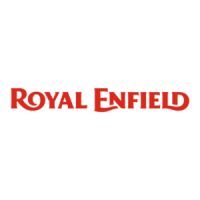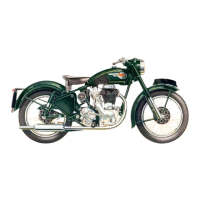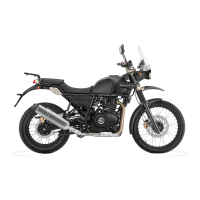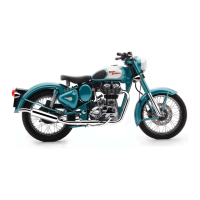"Super 5," "Continental":
Amal type 376/283. Monobloc 1
1
/
16
inch
bore.
"350 Bullet":
Amal type 376/297. Monobloc 1
1
/
16
inch
bore.
“250 Continental GT”
Amal type 389/217 Monobloc 1
1
/
8
inch bore
(See Section F.)
15. Air Cleaner
The air cleaner is Vokes Micro-Vee felt and gauze
dry filter, 5in. in diameter and housed in a
compartment of the toolbox. An air cleaner is fitted
to all export models and to the home market
"Crusader 250," and "250 Trials," but not to the
home market "250 Clipper," "Crusader Sports,"
"Super 5," "Continental" "GT," and "350 Bullet."
16. Lubrication. (See Figs. 2 and 3)
Lubrication is by the Royal Enfield Dry-Sump
System, which is entirely automatic and positive in
action. The oil tank is integral with the crankcase,
ensuring the full rate of circulation immediately the
engine is started and rapid heating of the oil in cold
weather.
The oil pump is of the duplex type positively
driven at half engine speed and having two pistons,
one for pumping oil under pressure to the big end
and the other for returning the oil from the crankcase
back to the tank and to the valve rocker gear. The
return pump has a capacity of approximately three
times that of the feed pump, which ensures that oil
does not accumulate in the crankcase.
The pumps are of the oscillating disc type and
both pistons are located in the same disc but they are
not interconnected and can be regarded as two
separate pumps.
The operation of the pumps themselves is
explained on page 5. (See Figs. 4a and 4b.)
The feed pump sucks oil from the tank through a
pipe in the chaincase and delivers it through another
pipe to the filter and thence through an internal
passage drilled in the primary chaincase to a central
hole in the crankshaft.
From here the oil passes along drilled holes in the
crankshaft, assisted by the centrifugal action caused
by the rotation of the engine to the big end. The
cylinder and piston and the crankshaft main bearings
are lubricated by oil splashed off the big end bearing,
the oil finally collecting in the small sump at the
bottom rear of the crankcase.
From here lubrication differs between early and
later models as follows:
Early Models
(see Fig. 2)
Earlier models have the top of the oil filter
connected to a pressure control valve of the spring
loaded ball type, which is screwed into the top of the
crankcase, and this valve discharges into the oil tank.
The return pump sucks the oil from the crankcase
through a third pipe in the chaincase and delivers
it through a fourth pipe to a drilled passage in the
top of the crankcase near the filter. From there
most of the oil passes through a second valve
back to the oil tank but the back-pressure caused
by this valve forces some of the oil in the drilled
passage through an external pipe connected to a
union on the top of the crankcase to the rocker
bearings on the cylinder head.
The oil which passes through the rocker
bearings lubricates the valve stems and pushrods
and flows down the pushrod tunnel into the
camshaft housing. Here it lubricates the cam
followers, the cams and the gear train which
drives the contact breaker and pump.
The oil level in the camshaft housing is con-
trolled by a hole through which the oil overflows
into the primary chaincase, lubricating the timing
chain and primary chain.
Another hole between the bottom of the
primary chaincase and the crankcase maintains
the level of oil in the chaincase, the surplus
flowing into the crankcase sump to be picked up
by the oil return pump.
Later Models
(see Fig. 3)
Later models have dispensed with the relief
valve, which is situated in the top of the crankcase
of earlier models, the spring loaded oil pump
discs now entirely controlling oil pressure.
The return pump sucks the oil from the crank-
case through a third pipe in the chaincase and
delivers it through a fourth pipe to a drilled
passage in the top of the crankcase near the filter.
From there most of the oil passes through a
spring loaded ball valve back to the oil tank but
the backpressure caused by this valve forces some
of the oil in the drilled passage through an
external pipe connected to a union on the top of
the crankcase to the rocker bearings on the
cylinder head.
The oil which passes through the rocker
bearings lubricates the valve stems and push rods
and flows down the push rod tunnel into the
camshaft housing. Here it lubricates the cam
followers, the cams and the gear train which
drives the contact breaker and pump.
The oil level in the camshaft housing is con-
trolled by a hole through which the oil overflows
into the oil tank. Oil from the crankcase, passing
through the main journal bearing and through the
pressure equalising hole situated above the main
bearing, lubricates the primary chain. The oil level
in the primary chaincase is governed by surplus
oil being flung by the chain into a weir situated in
the top rear portion of the case; a hole from the
weir drains the oil back to the oil tank.

